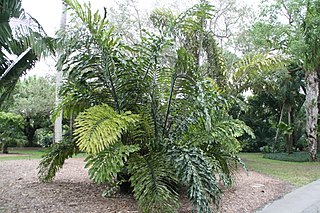Beccari, Arecaceae

|

|

|

|

|
|
Beccari, Arecaceae |
|
Present on Pacific Islands? yes
Primarily a threat at high elevations? no
Risk assessment results: Evaluate; score: 2 (Hawaii-Pacific Weed Risk Assessment for Arenga undulatifolia)
Other Latin names: Arenga ambong Becc.; Saguerus undulatifolius (Becc.) Kuntze
Common name(s): [more details]
|
Dusun: polod |
|
Unknown: aren gelora, jaka |
Habit: tree
Description: "A massive, clustering palm with stems growing up to 3 m. The leaves are dull green with regularly arranged leaflets. These are lobed and highly undulate, with a paler lower surface. The inflorescences are pendulous, the male flowers with a musty smell. The flowers are pinkish and the fruits green." (Projec Ethnobotani Kinabalu)
Arenga undulatifolia has a solitary or densely-clustering trunk to 9m tall. The trunk is covered in mat of dark fiber, which eventually falls off, leaving behind a smooth, dark, green-ringed scar on the trunk. The leaves are large (to 3m) with widely-spaced 45-60cm leaflets. Leaflets have wavy margins, are dark green above, and silvery underneath. The petiole is short and thick. The inflorescence emerges from leaf bases and is usually hidden by foliag e. The tiny flower are greenish white. Fruits are round (2.5cm) and mature brown. (adapted from Singapore Government)
Habitat/ecology: "Found in limestone forest." (Singapore Government)
In cultivation, Arenga undulatifolia prefers well-drained soils, full sun, and moderate water. (Singapore Government)
Propagation: "Seed - a deep root is formed before the seedling emerges above soil level, and so the seed should be sown in individual, deep containers. Pre-soak the seed for 24 hours in warm water before sowing. It can take 3 - 6 months or more before signs of growth are seen above soil level. . . ." (Useful Tropical Plants)
Native range: Indonesia (Kalimantan, Celebes), Malaysia (Sabah, Sarawak), Philippines (Palawan) (GRIN)
Impacts and invaded habitats: (no invaded habitats or impacts known by PIER; please let us know if you know of such information we should add here)
Presence:
| Pacific | |||
|
Country/Terr./St. & Island group |
Location |
Cited status &
Cited as invasive & Cited as cultivated & Cited as aboriginal introduction? |
Reference &
Comments |
|
State of Hawaii
Hawaiian Islands |
Maui Island |
introduced
cultivated |
Starr, Forest/Starr, Kim (year unknown)
accessed 20180414 |
|
Philippines
Philippine Islands |
Palawan |
native
|
U.S. National Plant Germplasm System (year unknown)
accessed 20171201 |
| Pacific Rim | |||
|
Country/Terr./St. & Island group |
Location |
Cited status &
Cited as invasive & Cited as cultivated & Cited as aboriginal introduction? |
Reference &
Comments |
|
Central America
Central America (Pacific rim) |
Costa Rica (Republic of) |
cultivated
|
Stang, David (2008)
accessed 20180414 |
|
Indonesia
Indonesia |
Indonesia (Republic of) |
native
|
U.S. National Plant Germplasm System (year unknown)
"Kalimantan, Celebes", accessed 20171201 |
|
Malaysia/Indonesia
Borneo |
Sabah |
native
|
U.S. National Plant Germplasm System (year unknown)
accessed 20171201 |
|
Malaysia/Indonesia
Borneo |
Sarawak |
native
|
U.S. National Plant Germplasm System (year unknown)
accessed 20171201 |
| Also reported from | |||
|
Country/Terr./St. & Island group |
Location |
Cited status &
Cited as invasive & Cited as cultivated & Cited as aboriginal introduction? |
Reference &
Comments |
|
Europe
Europe |
England |
cultivated
|
Dénes, Em&333;ke (2012)
accessed 20180414 |
Control: If you know of control methods for Arenga undulatifolia, please let us know.